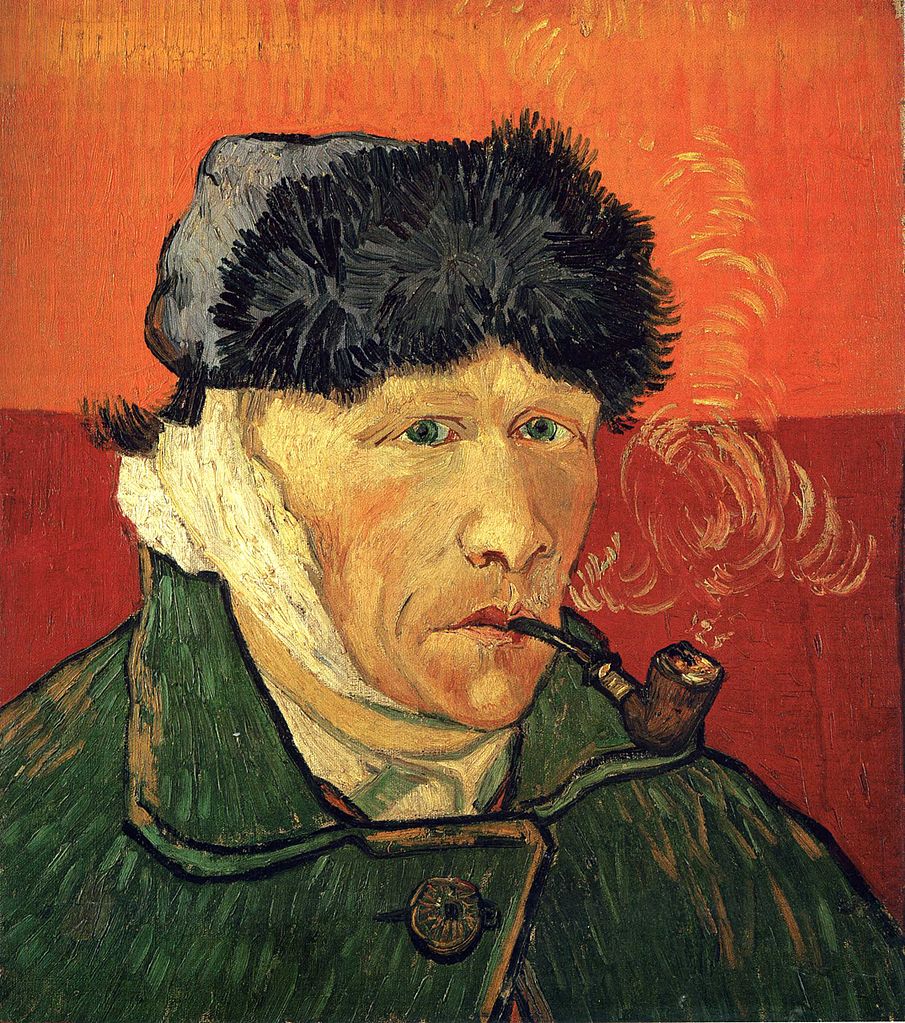Vincent Van Gogh was an admired artist, who was also a troubled and “tortured genius.” His artwork, Starry Night, Bedroom in Arles, and many others have earned him fame and recognition as one of the greatest artists of his time. But what many remember most about this artist is the story of his severed ear. Although his art is exemplary, his struggle with mental health and self-harm is admirable. His struggle was overlooked due to his incredible talent. He was successful as an art dealer, but as an artist, he had to prove himself with the headquarters of international art dealers, Gopil & Cie. During his lifetime, Van Gogh was the poster boy for the image of starving artist. His artwork was not recognized until much later in his career, which could have been a leading cause of his major depression and anxiety.1
Van Gogh, born in the Netherlands, decided to start his career in Paris in the 1880s, where many of the age’s great artists also resided. He believed he could get recognition for his pieces through his younger brother, Theo, who made his living as an art dealer. His brother introduced him to many artists, including Georges Seaurat, Camille Pisatto, and Paul Gauguin. Upon meeting these successful artists, Van Gogh was greatly inspired by their work and began creating his own artistic style, beginning in 1883. Later the same year, Van Gogh rented a small house in Arles, in the south of France. Paul Gauguin and Van Gogh became close friends and later roommates. They consistently bounced ideas off of each other and created a strong friendship.2

Like many friendships, theirs was rocky, and they found themselves drifting apart. Gauguin had moved on to a different artistic style and was exploring other ideas. Van Gogh at the time, had been reciprocating signs of depression and mental health issues, but at the time, these symptoms were considered normal. When Gauguin decided to explore other art spectrums, it involved moving out of the house he and Van Gogh shared. He broke the news to his roommate about his intentions, and this evidently this made Van Gogh go over the edge. He did not take the news lightly and both men began verbally arguing. Van Gogh had disappeared for a few hours and when he returned to confront Gauguin, he had a razor blade in hand threatening to hurt Gauguin.3
During the confrontation, however, Van Gogh was hesitant to hurt his friend and decided to turn the blade on himself and completely cut off his ear. Gauguin left him bleeding and alone. Van Gogh bandaged his head and began drowning himself in alcohol. During this episode, he walked out of his home and into the streets where he found a prostitute. The ear that he had severed off of himself had been neatly wrapped in a cloth; since Van Gogh was still heavily intoxicated, he decided to present this token to the prostitute. Patiently, she ran off and alerted the police about her encounter and they immediately rushed to his home.4
Shortly before Christmas Eve, Van Gogh was found by police in his bed, partially conscious and with major blood loss. Authorities rushed him to the hospital where he surprisingly recovered. Meanwhile, Gauguin was brought into questioning, but gave no testimony on the incident. It was believed that Van Gogh had suffered a severe mental breakdown long before he had severed his ear, but that this created a ripple effect that led to lunacy. The real reason behind the infamous Van Gogh ear-cutting may never be known; Gauguin had promised Van Gogh a pact of silence on the situation in letters that they supposedly exchanged. 5

After the incident, Van Gogh was admitted into a psychiatric facility in hopes of recovering mentally and physically. The dramatic change was not helpful for such a troubled artist, and in July of 1890, Vincent Van Gogh ended his life with a revolver. Before his suicide, however, he created a very iconic painting, Self Portrait with Bandaged Ear 1889. Van Gogh intended to persuade his doctors that he was perfectly able to continue working and creating art by creating this self portrait. He presented his piece, leaving a trail of wonder for his supporters as to why he included certain details in this particular piece, mainly because he continued to paint himself in the same yellow house he and Gauguin shared. Doctors overlooked these details and allowed Van Gogh to leave the facility.6
The epidemy of many artists like Van Gogh is often associated with mental instability, drug use, and alcohol abuse. Van Gogh had an array of medical issues that were tied back to his coping mechanisms (alcohol abuse), and as a result, many did not understand the struggles he faced and degraded him as a person while idolizing his artistic talent. As said before, the real reason behind his mutilated ear will be unclear, but his work and talent will continue to inspire and educate.
- Adam Gopnik, “Van Gogh’s Ear,” The New Yorker, Literature Resource Center (January 4, 2010): 48. ↵
- “Who Really Cut Off Van Gogh’s Ear?” Weekend All Things Considered, Literature Resource Center, (May 2010). ↵
- “Who Really Cut Off Van Gogh’s Ear?” Weekend All Things Considered, Literature Resource Center, (May 2010). ↵
- Belinda Thomson, “Comparing lives: issues of balance in biographical writing,” Literature Resource Center, French Politics, Culture and Society 24, no. 2 (2006): 60. ↵
- Tim Suermondt, “All the Answers.” Literature Resource Ceter, Prairie Schooner 85, no.3 (2011): 47. ↵
- Tim Suermondt, “All the Answers,” Literature Resource Center, Prairie Schooner 85, no. 3 (2011): 47. ↵



170 comments
Donald Glasen
A beautifully constructed article. I love Van Gogh’s art, and I love reading and hearing people’s views on the different meanings of each painting. I also enjoy reading people’s theories as to what happened to Van Goghs ear some people like to think Gauguin had done it which I find to be a very interesting view. I find that people often tend to forget that artists, along with celebrities, and musical artist are people just like them. As people tend to just look past the symptoms and just figure that it’s a phase or just isn’t important. Thankfully as the days go on more people view mental health issues in a more serious light.
Makayla Soto
I was intrigued by this article because I actually love van Gogh and his art. I recently had just went to his art exhibit. I did not know much about him personally so reading this article was super educational. I did not know he had a lot of mental health issues and was dealing with depression. Thank you for touching on a subject like this and bringing awareness.
Serenity Kamenski
I remember vividly learning about Van Gogh in one of my classes, but it still carries an impactful punch reading about his life story. I like to think that people sometimes forget artists are people too, and how there is more to their story than simply what they created. Don’t get me wrong, Van Gogh’s art is unmatched and something no one could come close to producing, but he was also someone that struggled throughout his life. Your article did a great job on showing that side of him.
Phylisha Liscano
Great article! I really enjoyed getting the chance to read your article. I have never takes time to the learn about the back story of Van Gogh. This was a very interesting story. Very bold move cutting off an ear but it is understandable, there was not much help for mental health issues. I enjoyed the images you included they allowed me to get a visual aspect of Van Gogh and Paul. Great article and very straight to the point! I enjoyed!
Guadalupe Altamira
What a great article indeed this is! I always wanted to know what happened to Van Gogh and what his issues were during the important parts of his life. My interest in this article was to finally find out what happened to his ear because I saw his self-portrait before but did not know the reason behind it. His mental issues were ignored and resulted in many things that probably could’ve been prevented. I don’t like how they saw his mental issues worsen as “normal”. It’s a shame to see him fall into a spiral of mental health issues and his talent was only noticed after his death.
Daniela Iniguez-Jaco
Nice article! Growing up I always looked up to Van Gogh because his art connected to me. However, I never looked up his life and now that I am reading about it I wish he would have gotten the help he needed. Depression is not an easy thing to go through and during his time it must have been seen as scary. I feel like Gaugin should have reported his behavior to someone who could have helped him to avoid him killing himself. His art will always remain and we will always remember him.
Erick Velazquez
What a well-written article! I heard of Van Gogh losing his ear but I was not aware as to how he lost it. It’s super sad that Van Gogh struggled with depression and suffered in silence. I am familiar with his art, as we studied it a lot in my high school art class and now in one of my college courses. It’s interesting to see his art be brought up again, such as Starry Night, and many others.
Monserrat Garcia
Vincent Van Gogh has been one of my favorite artists since I was a child. I remember hearing a different story as to why he cut his ear and I believed it without any evidence so reading this article makes everything so much clearer. I did not know he had a friendship with Paul Gauguin and it is truly intriguing how it affected his mental health. I really liked how the author at the end describes how audiences disregarded Van Gogh as a human but idolized his art. Extremely interesting article, I thank you for writing about him.
Evangelina Villegas
This is an amazing article and a great choice of topic. Whenever I think of Van Gogh, the first thing that comes to mind is that he lost one of his ears. The second thing that comes to mind is the amazing art that he created. However, it never really occurred to me on how or why his ear was severed. To think that he was actually suffering with mental illness in his life had really opened my eyes on how I previously saw Van Gogh, that he was more than a famous artist.
Hoa Vo
Great Article! I really admire Van De Gogh’s artworks, every painting he created was a masterpiece of art. Especially the “Starry Night”, I am allured by the fancifulness of that painting, it showed the intricate interior that tormented him as he drew this. It is sad to see such a talented person go through life’s turbulence from a mental breakdown, depression leading to losing ear. Until the time of his death, the value of his works was noticed and famous.